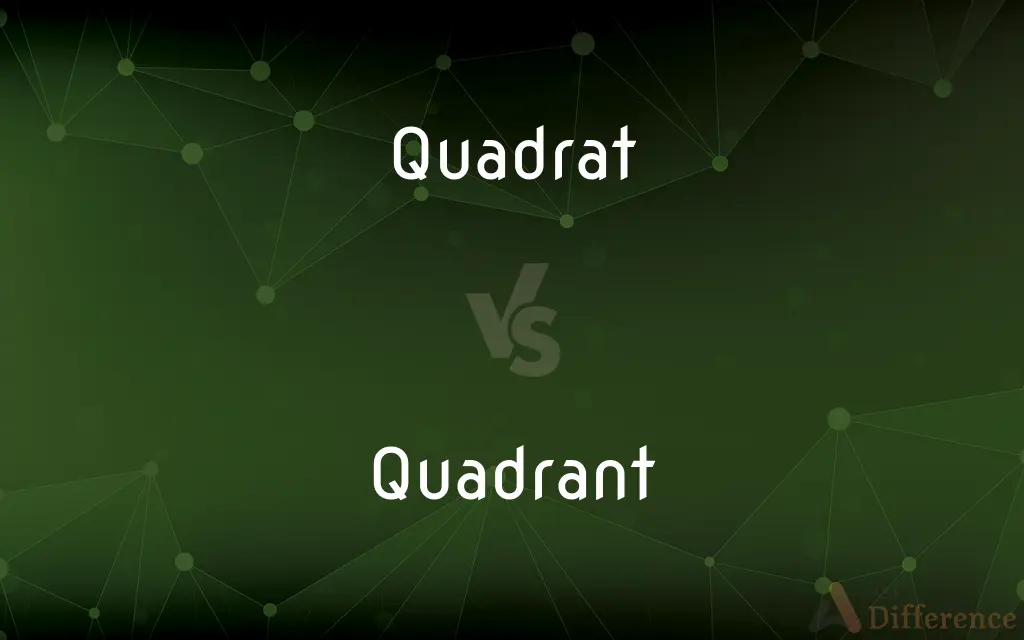Quadrat vs. Quadrant — What's the Difference?
By Tayyaba Rehman & Fiza Rafique — Updated on March 11, 2024
A quadrat is a tool for ecological study, sampling a specific area uniformly; a quadrant is a navigational tool or a section of a circle's plane.

Difference Between Quadrat and Quadrant
Table of Contents
ADVERTISEMENT
Key Differences
Quadrats are primarily used in ecology for sampling purposes, aiming to count species within a fixed area to estimate distribution across larger habitats. They are square or rectangular frames placed randomly or systematically on the ground. On the other hand, quadrants have historical significance in navigation and astronomy, used for measuring angles up to 90 degrees. They consist of a quarter-circle panel with a degree scale and were pivotal in early exploratory missions.
While a quadrat is simple in design, often made of wood, metal, or plastic, its effectiveness lies in its ability to provide repeatable and quantifiable data for ecological research. Quadrants, however, were intricate instruments, often made of brass or wood, equipped with sights and sometimes a plumb line to aid in the precise measurement of celestial bodies or terrestrial landmarks.
Quadrats are versatile tools used across various ecosystems, including terrestrial and aquatic environments, to study plant density, animal populations, or any biotic components. Quadrants were essential in the era before the widespread use of more advanced navigational tools like sextants and GPS, specifically designed for navigation by the stars or the sun.
In modern usage, quadrats remain crucial for fieldwork in ecology and biology, demonstrating their importance in environmental conservation and management. Quadrants, while mostly obsolete in practical navigation, are cherished as historical artifacts and serve educational purposes in understanding the evolution of navigational technology.
The use of quadrats can be tailored to specific research needs by altering their size and the method of placement, making them adaptable for various scientific investigations. In contrast, the design and function of quadrants were relatively fixed, with their use primarily confined to navigation and astronomy.
ADVERTISEMENT
Comparison Chart
Primary Use
Ecological sampling
Navigation and astronomy
Design
Square or rectangular frame
Quarter-circle panel with degree scale
Material
Wood, metal, plastic
Brass, wood
Application
Estimating species distribution
Measuring angles up to 90 degrees
Modern Relevance
Crucial for environmental research
Mostly obsolete, valued for historical study
Compare with Definitions
Quadrat
Essential for environmental management and conservation efforts.
Quadrats helped determine the most biodiverse areas needing protection.
Quadrant
Used before the advent of modern navigational devices.
Before GPS, quadrants were essential for determining one's position at sea.
Quadrat
A frame used in ecological studies to sample specific areas.
Scientists used a quadrat to study plant diversity in the forest.
Quadrant
A historical instrument in astronomy and navigation.
Astronomers relied on quadrants to track celestial movements.
Quadrat
A tool for quantifying the distribution of organisms within an ecosystem.
By placing quadrats along a transect, researchers can estimate animal populations.
Quadrant
Made of materials like brass or wood, often with intricate designs.
The museum's quadrant collection showcases the evolution of navigational tools.
Quadrat
Versatile in application, from terrestrial to aquatic ecosystems.
Quadrats are essential for coral reef surveys to assess biodiversity.
Quadrant
Valued today for educational and historical significance.
Quadrants in classrooms help students understand early exploration methods.
Quadrat
Adaptable in size for different research needs.
Large quadrats were deployed to sample vegetation, while smaller ones were used for insect populations.
Quadrant
A navigational tool for measuring angles up to 90 degrees.
Sailors used quadrants to navigate the seas by the stars.
Quadrat
A quadrat is a frame, traditionally square, used in ecology, geography and biology to isolate a standard unit of area for study of the distribution of an item over a large area. Modern quadrats can for example be rectangular, circular, or irregular.
Quadrant
A circular arc of 90°; one fourth of the circumference of a circle.
Quadrat
(Printing) A piece of type metal lower than the raised typeface, used for filling spaces and blank lines. Also called quad2.
Quadrant
The plane area bounded by such an arc and two perpendicular radii.
Quadrat
Any of a group of small, usually rectangular plots of land used for sampling the occurrence of species or of archaeological artifacts.
Quadrant
Any of the four areas into which a plane is divided by the reference axes in a Cartesian coordinate system, designated first, second, third, and fourth, counting counterclockwise from the area in which both coordinates are positive.
Quadrat
(sciences) An area of land, marked for studying its plants, animals, soil, natural processes, etc.
Quadrant
A machine part or other mechanical device that is shaped like a quarter circle.
Quadrat
A quad; a blank metal block used to fill space in lines of type.
Quadrant
An early instrument for measuring altitude of celestial bodies, consisting of a 90° graduated arc with a movable radius for measuring angles.
Quadrat
(Egyptology) A virtual rectangular subdivision of a line or column of hieroglyphs within which a group of hieroglyphs is arranged.
Quadrant
One of the four sections made by dividing an area with two perpendicular lines.
Quadrat
A block of type metal lower than the letters, - used in spacing and in blank lines.
Quadrant
(mathematics) One of the four regions of the Cartesian plane bounded by the x-axis and y-axis.
Quadrat
An old instrument used for taking altitudes; - called also geometrical square, and line of shadows.
Quadrant
(geometry) One fourth of a circle or disc; a sector with an angle of 90°.
Quadrant
(nautical) A measuring device with a graduated arc of 90° used in locating an altitude.
Quadrant
(college basketball) One of the four categories of team wins and losses, as categorized by strength of schedule.
Quadrant
(obsolete) A square or quadrangle.
Quadrant
The fourth part; the quarter.
Quadrant
The quarter of a circle, or of the circumference of a circle, an arc of 90°, or one subtending a right angle at the center.
Quadrant
One of the four parts into which a plane is divided by the coördinate axes. The upper right-hand part is the first quadrant; the upper left-hand part the second; the lower left-hand part the third; and the lower right-hand part the fourth quadrant.
Quadrant
An instrument for measuring altitudes, variously constructed and mounted for different specific uses in astronomy, surveying, gunnery, etc., consisting commonly of a graduated arc of 90°, with an index or vernier, and either plain or telescopic sights, and usually having a plumb line or spirit level for fixing the vertical or horizontal direction.
Quadrant
A quarter of the circumference of a circle
Quadrant
A quarter of the circumference of a circle
Quadrant
Any of the four areas into which a plane is divided by two orthogonal coordinate axes
Quadrant
The area enclosed by two perpendicular radii of a circle
Quadrant
A measuring instrument for measuring altitude of heavenly bodies
Common Curiosities
What is the main purpose of a quadrat?
To sample specific areas within an ecosystem for ecological research.
Can quadrats be used in aquatic environments?
Yes, quadrats are adaptable for both terrestrial and aquatic ecosystem studies.
How do quadrats help in environmental conservation?
By estimating species distribution, they identify biodiverse areas needing protection.
How is a quadrant used in navigation?
It measures angles, particularly celestial bodies, to aid in navigation.
Why are quadrants considered obsolete?
Modern navigational tools like GPS and sextants have replaced them for most practical purposes.
Are quadrants still used today?
Mostly for historical and educational purposes, not practical navigation.
What kind of data can quadrats provide?
Data on plant density, animal populations, and overall biodiversity.
Were quadrants used in astronomy?
Yes, they were used to measure the positions of stars and planets.
How do researchers decide on the size of a quadrat?
The size is determined based on the research goals and the ecosystem being studied.
What materials are quadrats made from?
They can be made from wood, metal, or plastic, depending on the requirement.
How do quadrats contribute to science?
They provide quantitative data essential for understanding ecological dynamics.
Is there a standard size for quadrats?
No, the size can vary based on the study's needs and the type of ecosystem.
Why are quadrats essential for fieldwork in ecology?
They allow for systematic sampling of areas, crucial for accurate environmental assessment.
What replaced quadrants in navigation?
Sextants and global positioning systems (GPS) are among the tools that replaced them.
What makes quadrants unique among navigational tools?
Their ability to measure angles precisely using simple mechanical means.
Share Your Discovery

Previous Comparison
Serotype vs. Serogroup
Next Comparison
Lily vs. TulipAuthor Spotlight
Written by
Tayyaba RehmanTayyaba Rehman is a distinguished writer, currently serving as a primary contributor to askdifference.com. As a researcher in semantics and etymology, Tayyaba's passion for the complexity of languages and their distinctions has found a perfect home on the platform. Tayyaba delves into the intricacies of language, distinguishing between commonly confused words and phrases, thereby providing clarity for readers worldwide.
Co-written by
Fiza RafiqueFiza Rafique is a skilled content writer at AskDifference.com, where she meticulously refines and enhances written pieces. Drawing from her vast editorial expertise, Fiza ensures clarity, accuracy, and precision in every article. Passionate about language, she continually seeks to elevate the quality of content for readers worldwide.














































